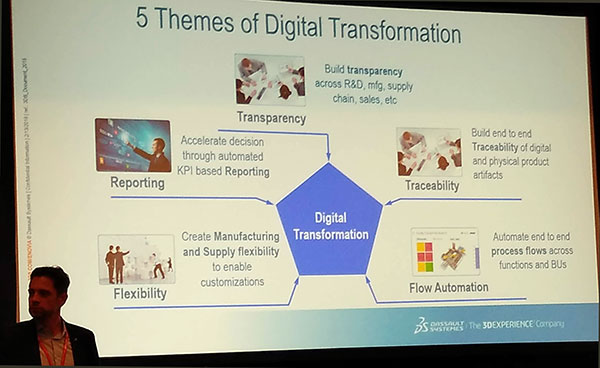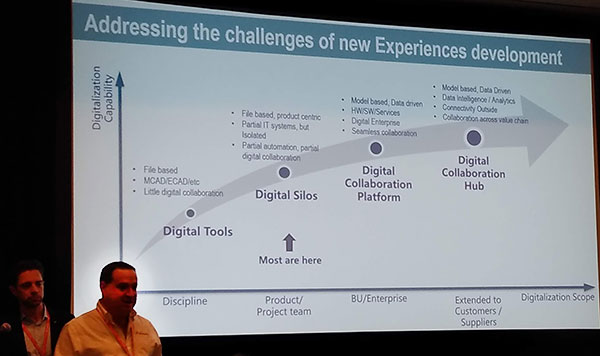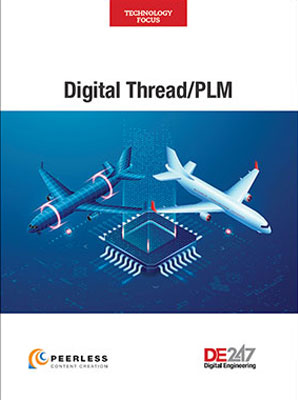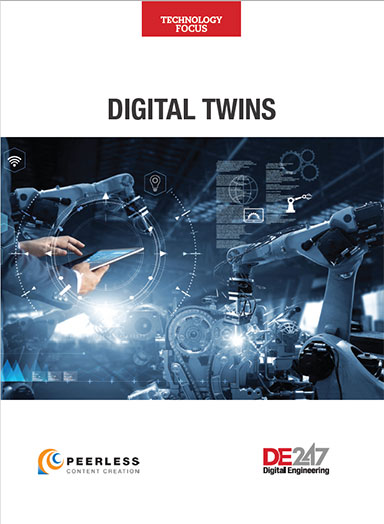Exploring Digital Transformation as an Evolutionary Journey
SolidWorks World 2019 presentation advises to forget about specific products and work on themes that match your digital transformation agenda.

Digital transformation has five parts, says Dassault’s Louis Feldstein: Reporting, Transparency, Traceability, Flow Automation, and Flexibility. Image courtesy of Randall Newton.
February 22, 2019
When your chosen engineering software vendor has more than 1,000 products, how to you even start to consider all the options for process improvement? The answer emerging from the last of seven sessions in the Digital Transformations track at this year’s SolidWorks World was to forget about specific products and work on themes that match your digital transformation agenda.
“You eat the elephant one bite at a time,” said Louis Feldstein, the worldwide director of high tech solutions for Dassault Systemès, the parent company of SolidWorks. At best, digital transformation is an evolutionary journey, Feldstein said. Startups have an advantage in starting with the latest technology and processes, but most existing engineering teams have to “find where they are on the roadmap” and build a plan, he added.
Define Digital Transformation
Dassault says the journey of digital transformation starts with a definition; they like the one from research firm IDC:
“Digital Transformation is the continuous process by which enterprises adapt to the disruptive changes in their customers and markets by leveraging digital competencies to innovate new business models, products, and services that seamlessly blend digital and physical and business and customer experiences while improving operational efficiencies and organizational performance.”
This definition gives wide latitude in where to look for both the easy fixes and the major pain points.

Sometimes the first steps do not come as a result of a great visionary plan. Feldstein told of one client who only wanted to solve a single problem. It seemed their internal processes usually ended up with Marketing having product imagery from a beta version of the product. “Every customer has a different set of problems,” he said. In each situation, the company needs to identify key performance indicators (KPIs) to work on first.
KPIs were made famous by business researcher Peter Drucker, who once summed up the concept of key performance indicators by saying: “What gets measured gets done.”
Five Digital Transformation Themes
Dassault’s David Mann, a business development director, said there are five themes to keep in mind as a company studies how to initiate or improve digital transformation:
- Reporting: Data required by other processes should be delivered automatically, not on demand.
- Transparency: All processes should be visible to all parts of the organization.
- Traceability: Every artifact, digital or physical, should be trackable.
- Flow Automation: Every process flow should be automated end-t0-end, not subject or requiring manual interventions.
- Flexibility: Design workflows to improve manufacturing and supply chain flexibility.
Two products on the market can serve as metaphors for the power and potential for digital transformation, said Mann: the commercial drone and the electric automobile. Small personal drones have gone from being radio controlled analog machines to software-driven digital devices.
The typical electric car has become “a tablet with wheels,” Mann said. “The next generation are not cars but autonomous AI devices.” As the automotive industry moves toward a design ratio of 40% mechanical and 60% electronic, “the supply has been turned upside down.” Such shifts, Mann said, are driving digital transformation.
Dassault Systemès is best known for its CAD tools CATIA and SOLIDWORKS, but Feldstein said only a small portion of digital transformation is about CAD. “We are CAD neutral for the next generation of transformation,” he said. Focusing on the capabilities of single tools results in “each silo working faster and faster.” The new changes for digital transformation are about opening processes up to the wider enterprise as described in the five themes mentioned above.
Four Digital Transformation Stages
Mann described the path of digital transformation as a series of four challenges or levels of awareness. The first is Digital Tools, which focus on a specific discipline. Second is Digital Silos, which has a focus on product and project teams. Most manufacturers are on this level, Mann said. The third is Digital Collaboration Platform, which covers a business unit or the complete enterprise. The fourth is Digital Collaboration Hub, which extends the power of digital transformation beyond the organization to suppliers and customers.
Two questions from the audience came in response to the “digital challenges” chart. The first question was about how to integrate either enterprise resource management (ERP) or supply chain management (SCM) into a digital transformation scheme. On a practical level, Feldstein says, there is no simple integration of ERP or SCM because almost every company using either has added a high degree of customization to their installations.
A second question asked about the relationship of product lifecycle management (PLM) to digital transformation. “PLM is a workgroup tool,” Mann told the audience. “This is a holistic explanation.”
More Dassault Systemes Coverage

Subscribe to our FREE magazine, FREE email newsletters or both!
About the Author
Randall S. Newton is principal analyst at Consilia Vektor, covering engineering technology. He has been part of the computer graphics industry in a variety of roles since 1985.
Follow DE






